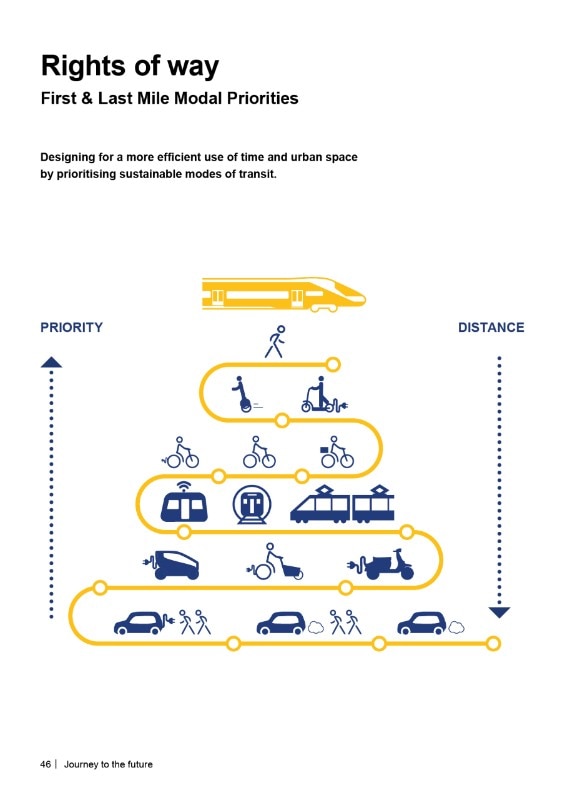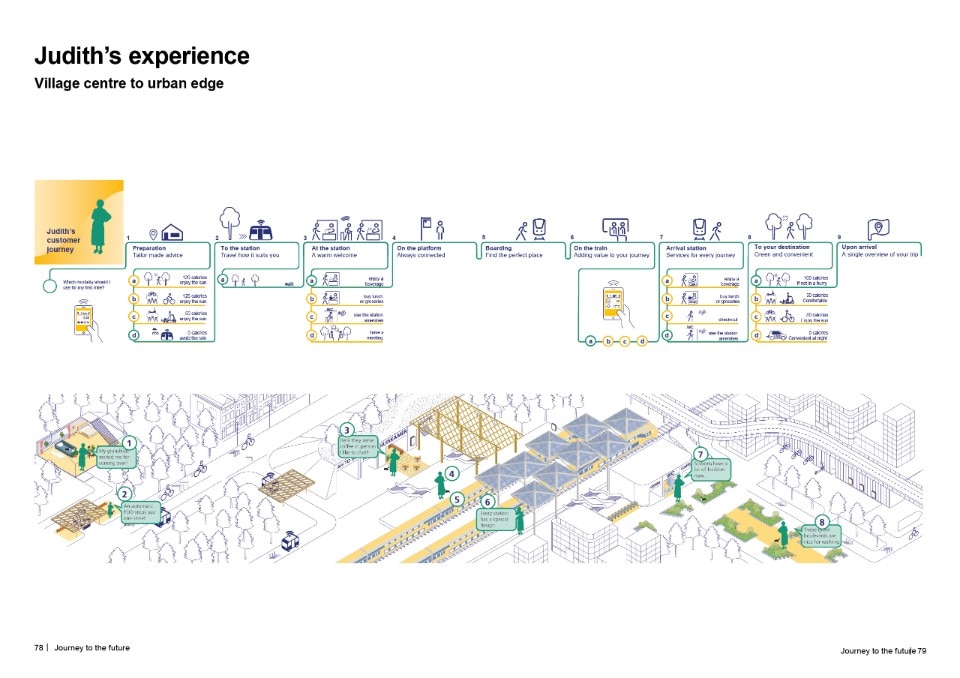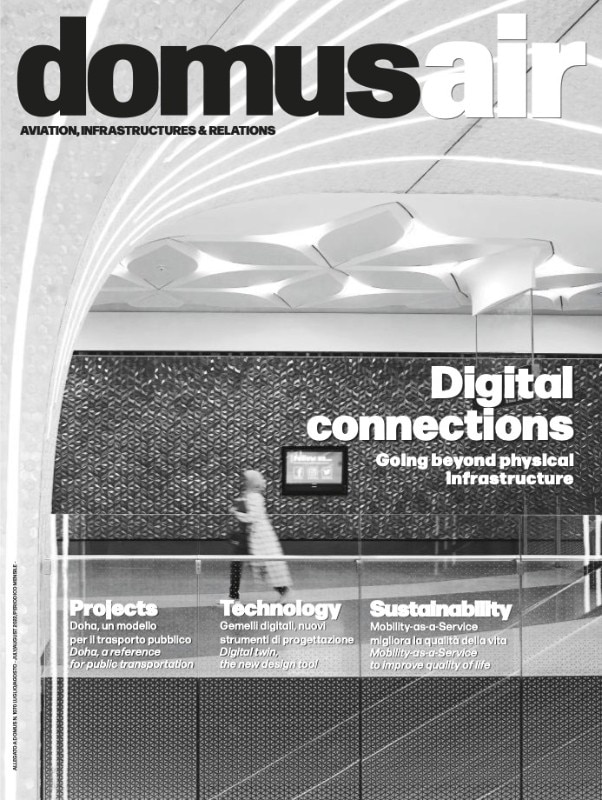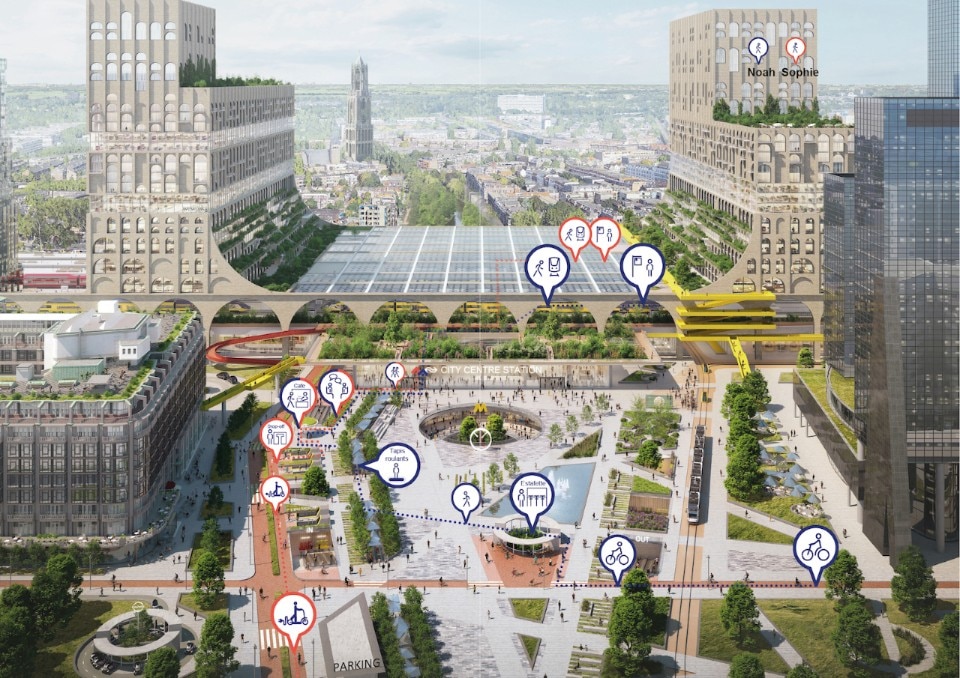The Digital Age and smart seamless mobility systems are changing both the way we travel and our environment. The growing demand and desire to travel bring new challenges and creates the opportunity for an important change in how people move through the urban environment. As a result, station surroundings and the routes to/from stations also need to adapt to future needs.
For the Dutch Railways (NS), the journey of the future is a question for today. In the document ‘Public Transport in 2040’, the Dutch government and multiple stakeholders have set ambitious targets to improve public transport. Among these goals, increasing capacity by 40% and offering a sustainable journey that is 100% energy neutral. These will contribute to creating a highly attractive travelling experience. Our role is to successfully innovate by transforming. Mecanoo (architecture firm based in Delft, Netherlands, ed) believe that the best way to predict the future is to design it.
User-centred mobility services
A seamless mobility system integrating public, shared, and private transport is the way forward. The strategy to implement this plan is a human-centred service, that looks at the door-to-door journey from the passenger’s perspective. While travelling, people want to feel in control,
enjoy an attractive, personalised experience and have the freedom to use their travel time as they see fit. Offering a variety of travel options and personalised mobility choices will provide a streamlined journey while raising sustainability awareness.

Sharing Economy and Mobility-as-a-Service
The advent of Mobility as a Service (MaaS) offers travellers a joint digital channel to plan, book, and pay for the entire trip. By integrating MaaS, passengers will face little or no inconvenience when switching between various transport types, making their journey attractive, comfortable, and personal. To create a seamless network covering public, private and shared transport for the entire journey, Mecanoo identified three types of stations based on location and function: the City Centre Station (Urban Core), the Transfer Station (Urban Edge) and the Hub Station (Rural). Each of these hubs comes with a specific character and impact on their respective surroundings.
Urban setting, layout and peak passenger flows create different challenges and offer distinct spatial design opportunities. A key point of our design approach was keeping the public space attractive while streamlining traffic flows. This required an integrated design of urban furniture, parking, and drop-off points to facilitate smart mobility solutions. Each mobility hub incorporates a family of spatial elements with a common design language and materiality to create a cohesive and inspiring station environment. These bespoke design solutions work hand in hand with MaaS to provide an easily adaptable and personal door-to-door passenger experience.
Public space must be attractive while streamlining traffic flows
Where to?
Study focused on the door-to-door journey from multiple passengers perspectives, to meet ambitious targets of the government note ‘Public Transport 2040’ on sustainability, passenger satisfaction and capacity. Happy passengers are at the heart of our strategy at NS. It is so much more than just operating a reliable rail service between two stations. It is about the complete journey from door to door, a journey with seamless connections that matches the passengers needs to the purpose of the journey.
Noah, Judith and Sophie
Innovations in mobility mean Noah, Sophie and Judith (the protagonists of the storytelling, ed) will have an increasing range of choices for getting from door to door. They want to have the most convenient journey possible, and we can provide this by offering them a range of choices. Depending on their situation and the purpose of their journey, they can make the choices that suit them best. Their decision could be influenced by the weather, the time of day, the urgency, the distance, their state of health, or even their frame of mind. Mobility is in high demand and this won’t be met by only building new infrastructure. Smarter use of available capacity is essential, which, for public transport, includes bottlenecks at the station and in the first and last mile. Travelling from one place to another is experienced as a single journey, even though it is made up of different parts and various modes of transport. By integrating mobility, with mobility as a service, passengers will face little or no inconvenience changing from mode to mode, making their journey attractive, comfortable and smooth.Our ‘journey to the future’ is very much a result of the research we have done into the situation today. Using Design Thinking, empathising and ideating with our passengers, we’ve looked at how our systems in their current form would cope with our objectives, and how they need to be developed so that our objectives can be attained.

A flexible set of mobility solutions
The popularity of services such as Uber, Greenwheels, Swapfiets and OV-fiets (Bike sharing service) indicates that we are developing a different attitude towards owning modes of transport. Practical constraints, costs, a need for flexibility and a reduced appetite for maintenance are driving a preference for a flexible set of mobility solutions rather than personal ownership.
Autonomous driving & On demand mobility
Seen by many as part of an unavoidable future, investments in and attention for autonomous vehicles are huge, but, there is a catch. Autonomous vehicles delivering a door-to-door journey are technologically the most complex and without mandatory ride-sharing will likely contribute to more cars moving empty seats than reducing the number of vehicles and kilometres they make. Assisted driving will definitely aid safety and efficiency of cars driving on highways, but the biggest potential now however is with Self Driving Shuttles, delivering on demand public transport driving along fixed routes. Especially in rural areas, these shuttles can keep public transport services at a cost-efficient level, even when numbers of users are low and distributed unevenly over the day.
Up and away... or not?
Urban air mobility solutions people moving drones are no longer science fiction but are close to become a reality. There is a big difference however between technological feasibility and an innovation that offers a true solution for a significant problem. Although it might solve an individuals need to avoid traffic jams, moving people through the air will substantially increase power consumption and the impact on environmental quality. Similarly, the Hyperloop will substantially reduce the individuals travel time from one destination to another, but it will hardly contribute to the enormous increase in demand for mid-range mobility. Though both are powered by interesting technology, when it comes down to meeting our objectives, there are simply not going to fly. Before these technologies come into use, actually, only an efficient system of interconnected means of transport will solve the mobility problems of Noah, Sophie and Judith.



